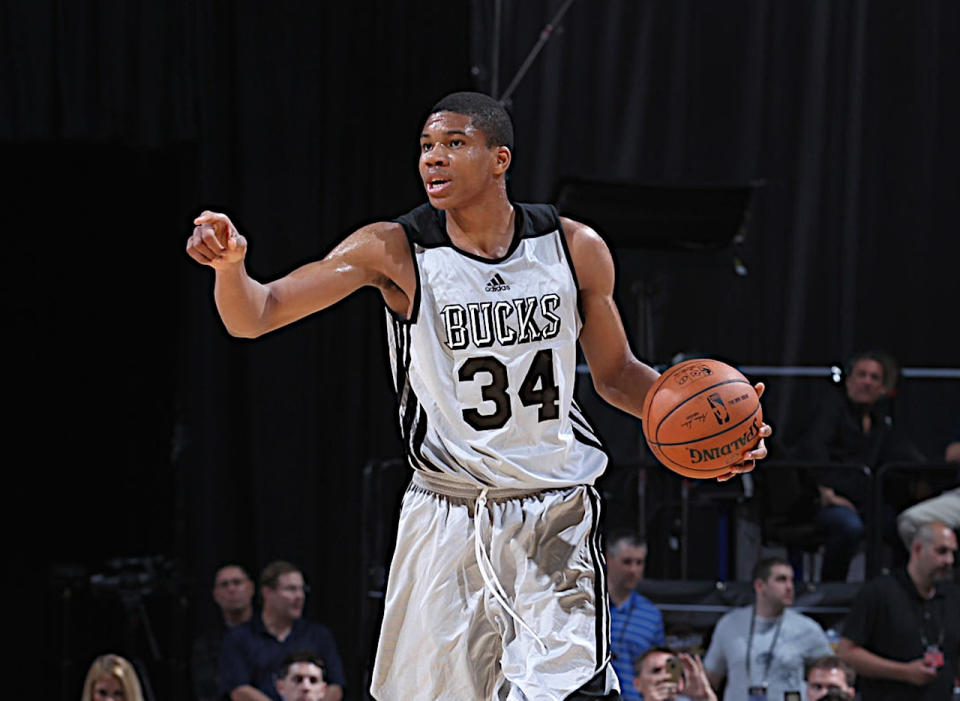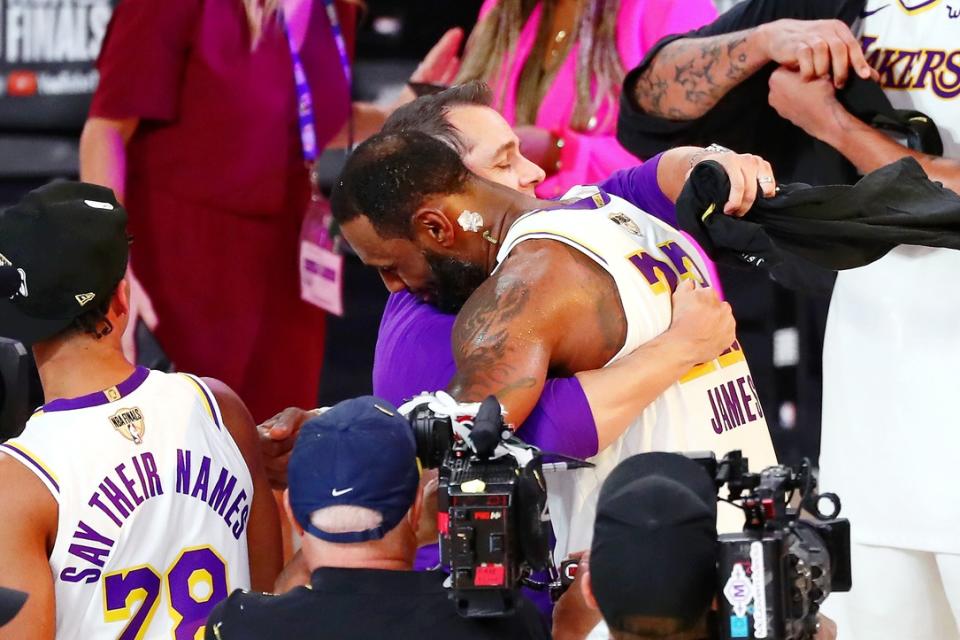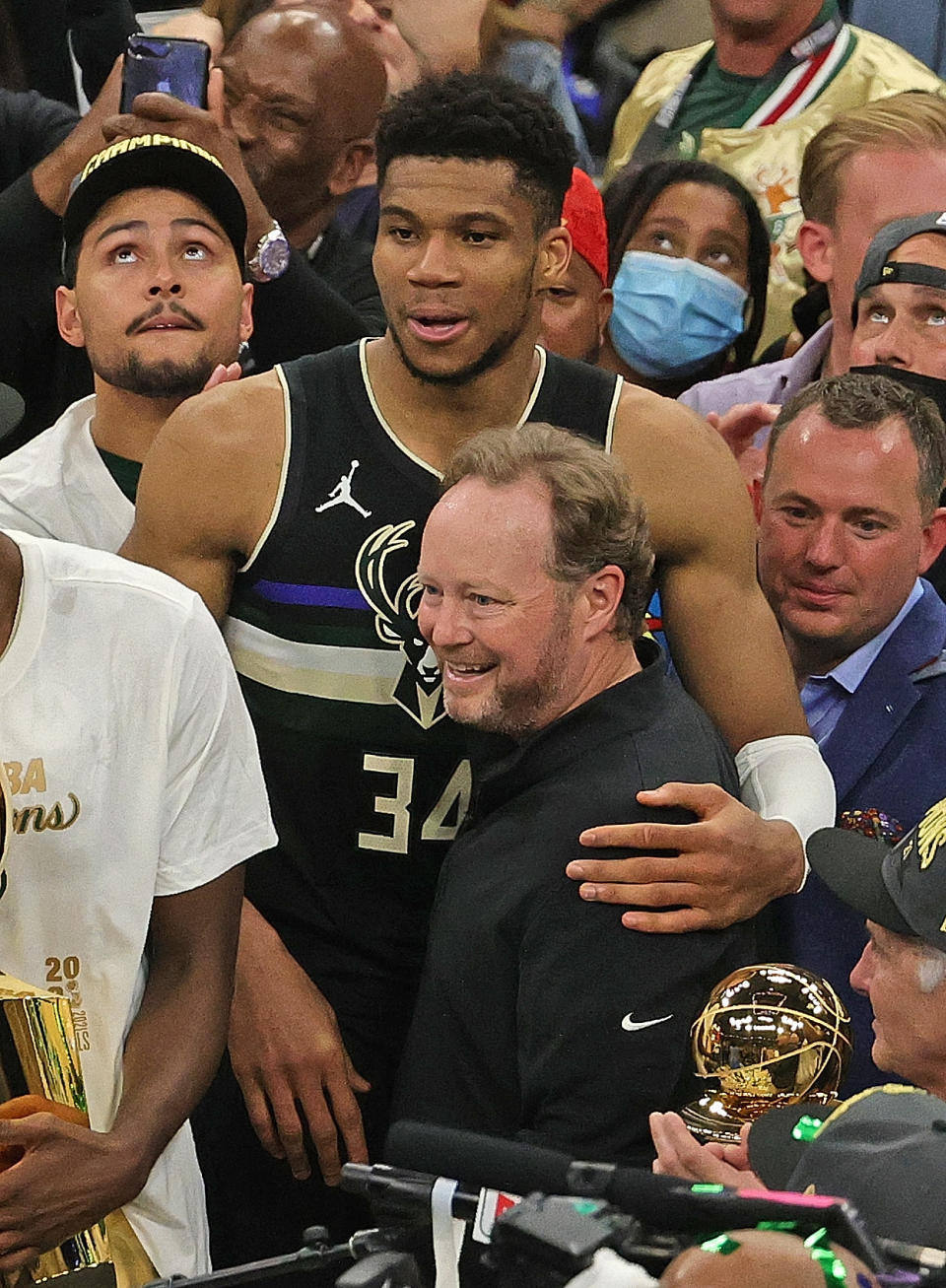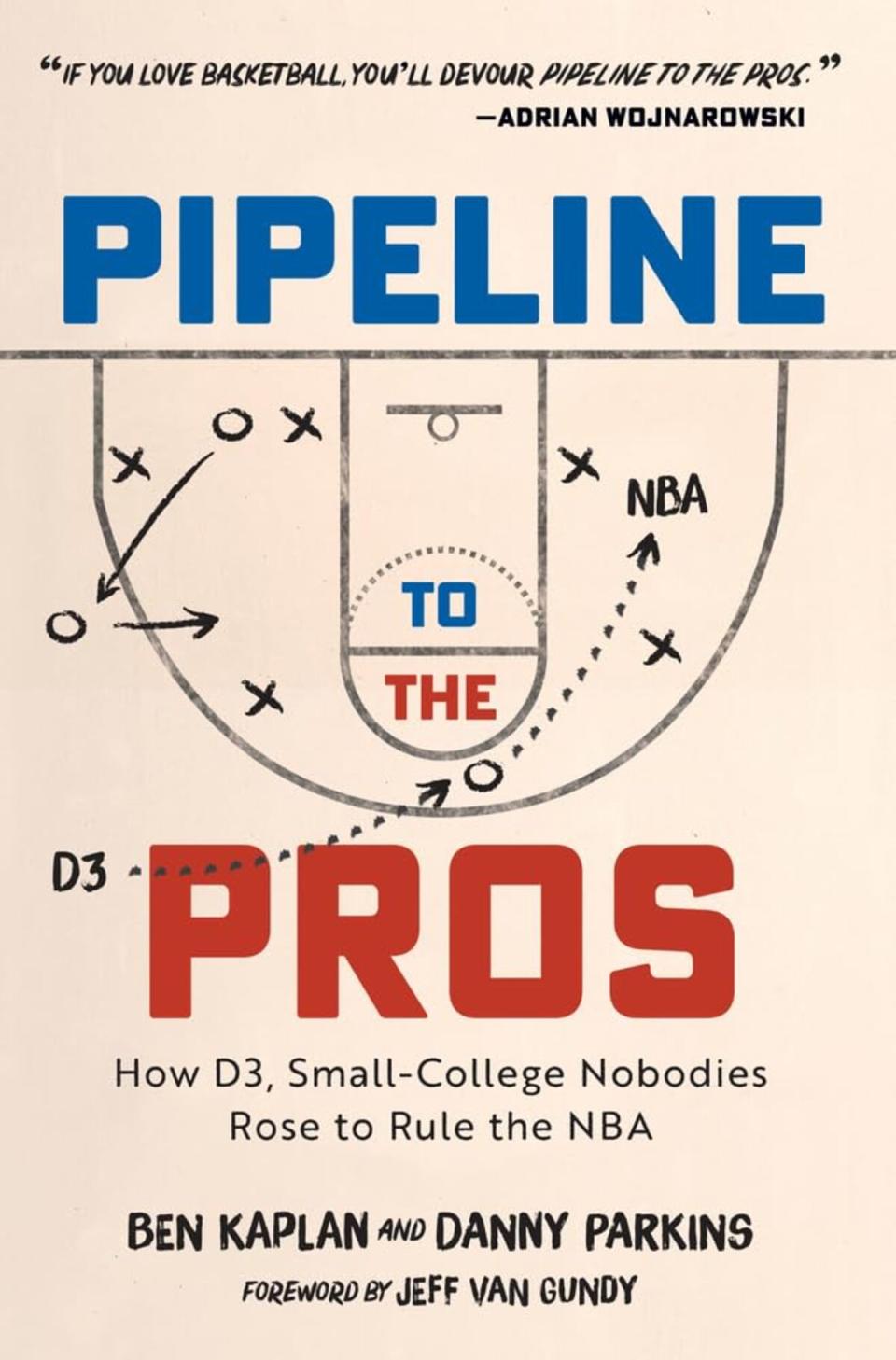Pipeline to the Pros: How D3, small-college nobodies rose to rule the NBA

Excerpt from Pipeline to the Pros by Ben Kaplan and Danny Parkins. Reprinted with the permission of Triumph Books. You can buy the book HERE
On March 10, 2020, Mike Budenholzer and the Bucks needed a break. They were back in Milwaukee, recuperating after a disastrous road trip. The three-game jaunt was a homecoming of sorts for Budenholzer, the Bucks’ head coach. The first game—a loss to Frank Vogel’s Lakers—was played just 40 miles due west of Pomona College, Budenholzer’s alma mater. Then the second loss—this one at the hands of the inferior Phoenix Suns—brought Budenholzer back to Arizona, the state where he grew up in the shadow of six older siblings, a politician mother, and a high school basketball coach father.
Fortunately, the schedule gods had the Bucks’ collective back: two days off, followed by a four-game homestand tipping off on March 12. There were rumors that, due to the new virus, they’d have to start playing games without fans. Oh well, Budenholzer figured. I played Division II. I’m used to empty stands.
Even after the losing streak, Budenholzer and the Bucks still had the NBA’s best record, thanks in large part to their star forward, Giannis Antetokounmpo. It had been only eight years since the Bucks plucked the gangly teenager from Athens, Greece, with the 15th pick in the 2013 NBA Draft. League commissioner David Stern pronounced his name carefully, enunciating each syllable: “The Milwaukee Bucks select…YAHnus Ah-det-oh-KOOM-bo.” Draft analyst Fran Fraschilla called him “the most mysterious” prospect selected that evening.
John Hammond, the Bucks general manager at the time, made the call to select the raw, relatively unskilled Antetokounmpo, betting on his size and his almost tangible desire to be great. At the post-draft press conference, Hammond told the media, “I do think this kid has potential All-Star talent.”

Team officials, intoxicated on the promise of tomorrow, do not generally temper expectations at those media sessions. So when Antetokounmpo became the league’s MVP in 2019, it wowed even Hammond, the man who put his job on the line to draft the so-called “Greek Freak.”
In the 2010s, it was en vogue for teams to avoid mediocrity and lean into losing. Bad teams got higher draft picks, higher draft picks had a greater probability of becoming stars, and stars won championships. So-so teams drafted so-so players and stayed so-so. Bucks ownership committed to winning as many games as possible, despite having no real shot at a championship.
Their approach was so novel, that ESPN’s Kevin Arnovitz wrote a profile of the team entitled, “What’s up with the Milwaukee Bucks?” Mediocrity, according to the league executives Arnovitz interviewed, was a treadmill. Hammond and the Bucks were pumping away, dripping sweat and gasping for air while their position in the league’s standings remained unchanged.
Antetokounmpo, who came into the league more Bambi on ice than graceful Buck, improved drastically from year to year. By his fourth season, the 22-year-old fulfilled Hammond’s prophecy, earning a trip to the NBA All-Star Game. The Bucks, however, were still on that treadmill. Through Antetokounmpo’s first five seasons, Milwaukee failed to advance beyond the first round of the playoffs.
In 2017, Hammond left the Bucks for the Orlando Magic. The following year, the Bucks finally hopped off the treadmill. With his spread offense and innovative defensive framework, new head coach Mike Budenholzer unlocked Antetokounmpo’s unique gifts. Both player and team took the leap almost immediately. The Bucks finished Budenholzer’s first season with the league’s best record. Antetokounmpo was named the NBA’s Most Valuable Player, and Budenholzer collected his second Coach of the Year trophy.
That first season ground to a halt with a loss in the Eastern Conference Finals. The disappointing end reminded NBA fans of Budenholzer’s tenure in Atlanta, where he overachieved in the regular season but fell flat in the playoffs. In year two, the Bucks continued to dominate, but it would all be for nought without at least a trip to the NBA Finals. Unexpected success in the NBA quickly morphs into heightened expectations, and heightened expectations can prove dangerous for a coach.
In July of 2020, the NBA relocated to Disney World to hold the playoffs in the safety of the so-called “Bubble.” Outside the Bubble it was a summer of great civil unrest. When, in the middle of the first round, footage surfaced of a police officer shooting a Black man named Jacob Blake in Kenosha, Wisconsin, members of the Bucks led a boycott that suspended play for three days.
Shortly after returning to the court, the Bucks fell in the second round to the underdog Miami Heat. Budenholzer didn’t make any excuses, even though there were plenty to go around due to the pandemic and the protests. It was widely understood that, should the Bucks underwhelm in the playoffs one more time, the organization would be forced to make a coaching change.

Unlike the Bucks, the Lakers regained their pre-pandemic form. They eventually toppled LeBron James’ former team, the Heat, to win the franchise’s 17th NBA championship. One of the league’s most iconic organizations, led by one of history’s most legendary players, was back on top. And Frank Vogel was the coach who got them there.
It was a season full of unpredictable winds and bumps, a journey befitting Vogel’s coaching career. His third stint as an NBA coach was finally the charm. Twenty-some years earlier, Vogel, a pre-med student at Juniata College in Huntingdon, Pennsylvania, did what most college students do in mid-December: he went home for a nice, long winter break.
Juniata’s basketball coach told Vogel and his teammates to return to campus shortly after the New Year. They’d have just one tune-up practice before a game on January 4. Vogel couldn’t stand it. “I was really blown away at how little commitment there was to really winning,” he said.
During the long layoff, the Division III point guard enviously watched his Division I counterparts on TV. His jealousy stemmed not from the fanfare, cheerleaders, or the television coverage but from their level of devotion. When an episode of SportsCenter covered University of Kentucky coach Rick Pitino’s decision to hold double sessions on Christmas Day, Vogel thought to himself, I’m more like that guy. I want to be that committed to basketball. So he took action.
As an encore to their disappointing run in the Bubble, Budenholzer and the 2020–21 Bucks finished third in the Eastern Conference, falling short of Vegas’ expected win total by three-and-a-half games. According to those same oddsmakers, the Bucks had only about a 10 percent chance of winning the title when the playoffs began. The odds reflected the consensus sentiment that the Bucks’ star player and head coach were not equipped to replicate their regular season success in the playoffs.
Antetokounmpo and Budenholzer emphatically proved their doubters wrong. In the face of rumors that he was on the chopping block, which persisted, and persisted, and persisted seemingly up until the moment he hoisted the 2021 championship trophy into the air, Budenholzer architected an impressive come-from-behind Finals victory. He was, and forever will be, an NBA champion.

When Budenholzer was interviewed during the trophy presentation, he deflected credit to the players, namely the two franchise pillars: Antetokounmpo and Khris Middleton. “Khris and Giannis, they built this,” Budenholzer said. “I’m just glad to be a part of what Khris and Giannis have done.”
Even though John Hammond was no longer with the team, he watched with pride at the culmination of his work in Milwaukee. The man who refused to tank managed to acquire Antetokounmpo, likely to go down as one of the greatest players in league history, in the middle of the first round. Then he snagged Middleton, a former second-round draft pick, as a trade throw-in.
In the postgame press conference, a champagne-soaked Antetokounmpo went out of his way to thank the Bucks’ former general manager. “John Hammond drafted me, believed in me, believed in my family, brought them over here,” Antetokounmpo said. “He made me feel comfortable.
He made me feel like I was his son when I was homesick and alone in the hotel.”
Many years before he was a talent evaluator, Hammond was a high school hooper with dreams of his own. That all came to an end one evening in 1971. Lying in a hospital bed, Hammond reckoned with the fact that there was no way the compound fracture in his leg would heal in time. He would miss his entire senior season, and the best small-college programs would look elsewhere. Heartbroken, he decided instead to follow his best friend, Scott Burgess, to tiny Greenville College in central Illinois. Maybe, if his leg healed, he could play basketball there.
That evening, when the doctor reset the bones in Hammond’s leg, Budenholzer was just two years old, doing his best to keep up with his older siblings. He eventually grew to be 6’1″ and, like his brothers before him, excelled on the hardwood. By his senior year in high school, Budenholzer dreamt of playing for his home state Arizona Wildcats. But Arizona’s coach, Lute Olson, was busy recruiting future NBA players, not scrappy coach’s sons like Budenholzer. So Budenholzer decided to follow in his older brothers’ footsteps and play Division III basketball at Pomona College.
Before he arrived on campus, the coach who recruited him, a former member of the Air Force by the name of Gregg Popovich, resigned to take a job with the San Antonio Spurs. Little did the teenage Budenholzer know, this string of disappointments set off a chain of events that would end with him coaching in the NBA.



